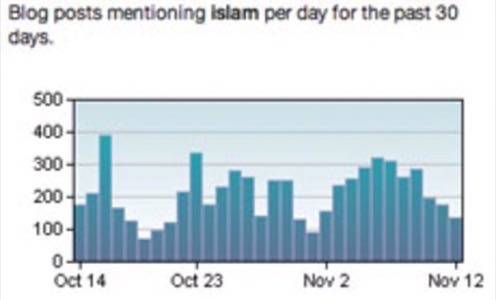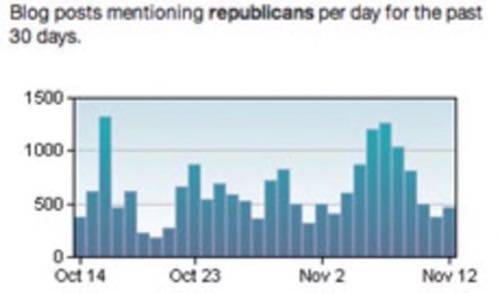Last week Marshall and I attended the Blog World Expo conference.
The gathering, held in Las Vegas, drew over 1,500 bloggers from different parts of the country and overseas. The conference lasted just over a day and a
half and had sessions that focused on a wide range of topics interesting to bloggers – from tools to money making.

It was a good conference and we had several interesting conversations, but I walked away with a strange feeling.
Somehow it seemed that blogging just isn’t that hot anymore. The feeling has been exacerbated by the latest slow down
in news. My feeds just do not update that often these days. Can it be that the digestion phase applies to blogs just as it
applies to startups? In this post we’ll investigate whether the blogosphere is going through a digestion phase.
Blogging Trends and Stats
Before looking at different use cases lets take a look at some trends and charts.
According to Google Trends, blog as a trend has been slowing down, while blogging never really
had much velocity.

On the other hand, if we compare blog to newspaper we clearly see that blog is on the rise
and that newspaper is on the decline.

According to David Sifry’s post in April of this year, the blogosphere is experiencing
exponential growth. The chart below indicates that Technorati alone indexed almost 35 million blogs in just 3 years – really quite a mind boggling number. The blogosphere has been doubling in that time about every 6 months, which means that if the trend held, there should be over 70 million blogs now.

Such phenomenal growth is even more surprising because there are simply not that many people who blog professionally. Sure there is money to be made via advertisements, but the amount is directly correlated with traffic. And traffic is not evenly distributed, it’s skewed toward a handful of popular blogs. What must
account for the growth in Sifry’s chart is the long tail. That is, people who are getting online to talk about their life, and connect with their family
and friends and don’t care if only a few people read their blogs.
Like everything else, blogging requires motivation. What is the driving force behind the blogosphere?
Lets take a look at different blogging groups and understand why people invest time into blogging.
Professional Blogging
It would be interesting to know how many bloggers from the Technorati Top 100 list blog professionally.
Likely not all of them. Beyond this list, we would probably see a sharp power law curve – making a living from
a blog is difficult. In each vertical – gadgets, technology, politics, celebrity gossip – there are a few very successful blogs
that get a large volume of traffic. In the long tail, and even in the middle tier, there is simply not enough traffic to run a blog as a sustainable business.
The separation can be seen in many ways – traffic charts, Feedburner subscribers, MyBlogLog community size, and average amount of comments per post.
The advertising prices between top tier blogs and middle tier blogs differ by an order of magnitude – thousands of dollars per month for a 125×125 banner ad
vs. at most, a few hundred for the same kind of advertising.
The image above is from geckoandfly.com.

Many aspire to make money by starting a blog on a niche topic, but very few succeed. Darren Rowse, over at ProBlogger
has been running a fantastic blog on how to make money online, and in his latest poll
Darren asked his readers how much money they made from blogging in October:


At best, 10% out of 1,300+ respondents made decent money. And likely most of the people who indicated they made over $15,000
are likely blogging in one of a handful of lucrative niches. A quarter of the voters made no money at all. Of those who attempted to make money,
most did not make much. What is the story behind these bloggers? We look at them next.
Blogging for Business and Pleasure
Tyler Colman, has a PhD in Political Science and Economics and writes a popular wine blog called Dr. Vino.
The blog has been honored with many awards and has a good number of loyal readers. Just by spending a few minutes on the blog you will know that
this is a labor of love. Yet, there are ads. A couple of ads are for wineries and wine equipment, an ad for Wine Searchers, topped by
an out-of-place ad to search Amazon. And of course a long strip of Google AdWords. It is not likely that Tyler makes $15,000+ a month from
these ads. So why does he do it?

Like many people, Tyler does not like to leave the money on the table. Even if it is only $300 the money can be used to buy piano lessons for his kids or help fund an expensive hobby – like wine collecting. Mixing business and pleasure in blogs is common, particularly
when blogging about a hobby. Since advertising is widely accepted on the web,
blog readers readily accept it, and so bloggers have nothing to lose by adding them, even if it is obvious that the ads are not a huge money maker.
Blogging for a Cause
Money is the primary motivation for a lot of bloggers, but even more bloggers just don’t care if their blog brings in any cash.
They are blogging because they are passionate about a cause. We explored two big causes – religion and politics.
We used Technorati buzz charts to compare Christianity with Islam and Democrats with Republicans.




A couple of conclusions follow from the charts above. First, there is a bit more chatter about Islam than about Christianity.
Secondly, Democrats are out-blogging Republicans. And, finally, people appear to be more passionate about politics than about religion,
at least when it comes to blogging. Politics and religion are just two issues that people blog passionately about, though. There are blogs about education, sports, non-profit work, the environment, etc.
Personal Blogs
Money making blogs and causes make up just a fraction of the blogosphere. The long tail is all about self-expression.
Most people started blogging to stay in touch with their friends and family. As an example of this trend, the latest platform from
Six Apart, Vox, is specifically designed around family and friends.

Vox is important because it recognizes the value of blogging around a community. The platform is a response
to the fact that it is otherwise difficult to keep track of blogs by friends and family members. Because of this, most blogs in
the long tail have not enjoyed a vibrant life. Because RSS readers are still not widely in use, the only way many people know to
keep up-to-date with a blog is by bookmarking it and checking once it a while.
Clearly this does not scale and that is why older platforms have not been able to really connect people.
Six Apart was not the only company to recognize the problem. In a way, generic social networks like MySpace and more recently
Facebook have also exploited this flaw. Both have added some type of blogging to their social networking platforms and connected people with their friends by piping the updates into user profiles.
This tight integration, along with the rapid rise of microblogging, is causing a bit of a shift, at least in the long tail.
We will discuss the rising battle between traditional blogs, microblogging and social networks in a follow on post, but in the mean time, we turn to yet another kind of blog – spam blogs.
Spam Blogging
Most posts find their way through the blogosphere only to be republished on so called splogs (spam blogs).
These fake blogs work by scraping the content of legitimate blogs, republishing it, driving traffic via search engines and selling
ads. They are completely useless, but are clever pipes that just make money for the owner with little-to-no work. Very little can be done to stop
these blogs, since they’ve gotten great at remixing the content. They are so good sometimes that you do not realize
right away that you are reading a fake blog.

Over a year ago, Charles C. Mann wrote in Wired about the rise of spam blogs.
Mann’s article provides an indepth discussion on how and why these blogs are created. Another article, published in March 2006, cites a study that found that
there are more than twice as many fake blogs as real ones.
If that was the case a year and a half ago, today it is might possibly be 10:1. And since it is really easy to create a spam blog, the ratio is only likely to increase.
Conclusion
So what is going to happen to blogosphere? Can it sustain its current rate of growth? The growth of professional blogs might not be there, but likely, the blogosphere is going to continue to grow (if anything, because of an increasing amount of spam). But there is likely to be a correction.
The long-tail of the blogosphere might be in danger. Spam is only a part of it, but competition from social networks and microblogging
platforms is quite significant. Only time will tell how things play out.
Please tell us why you blog. Does making money on your blog matter to you? What do you see in the future for the blogosphere? Is the blogosphere going through a digestion phase?
















